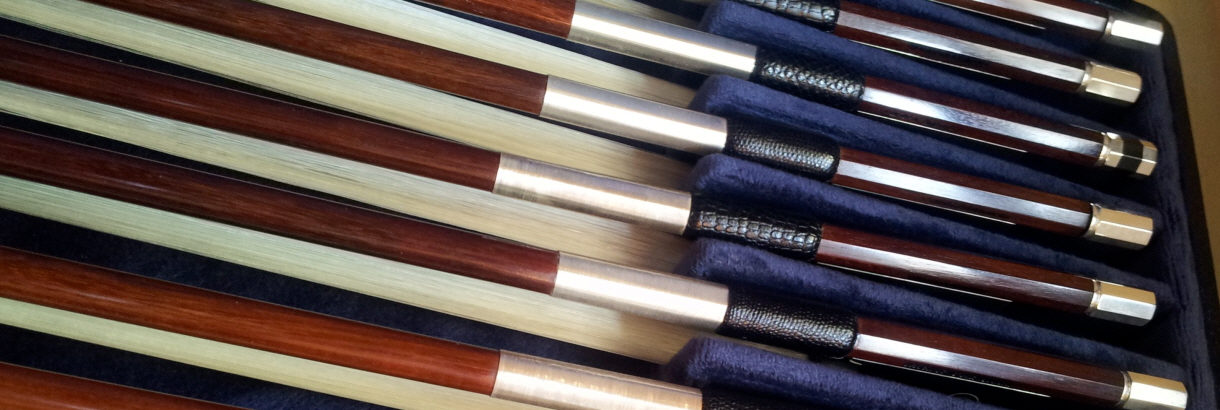Post by julesd68 on Jun 30, 2018 17:22:58 GMT
A most interesting visit to a London string instrument specialist today.
My son has a violin exam next week and yesterday he noticed a fraying string that needed replacing. So we dealt with that first but he also asked to look at bows to possibly replace his no name cheap as chips Chinese effort, which actually manages to sound remarkably good with his 100 year old French violin.
Bows are generally made from three materials - Brazilwood, which is a generic term for inexpensive tropical hardwoods found in Brazil and other countries; Pernambuco, a fabled, prized and now rare and expensive Brazilian wood due to strict export regulations; lastly there’s the new kid on the block, carbon fibre, which ranges from cheap to mid prices. Bows can cost from under 50 quid up to tens of thousands for rare bows from prized makers. We were given 5 or 6 wooden bows to audition within a set price range. Choosing a bow isn’t easy. It’s a bit like auditioning upgrades or accessories in your hi-fi system, but the difference is here that you are not just listening out for sonic differences, subtle or obvious, you are considering the feel and response of the bow when playing, so you need to subject it to a wide range of bowing techniques.
About a year or so ago we went to a different shop to look at bows and walked out keeping the old Chinese one - we couldn’t hear any differences between them! Now maybe that could have been due to the room acoustic or the fact that my son was less advanced; anyway, the time was obviously not right because this time we could hear obvious differences between them. The sales adviser left us alone to audition them which was great, so my son could make up his own mind on their merits. The cheaper bows in Brazilwood were very good bows offering excellent clarity and my son liked this. But changing to Pernambuco bows brought more profound differences - some gave a more ‘antique’ and mellow old-school sound and neither of us found this appealing. The best we found was a silver mounted Pernambuco bow and after multiple comparisons (not blind!) we both agreed it had the more pronounced clarity of the cheaper bow but also had much more depth and richness of tone. The bow also gave him more control with certain techniques and as a result, the notes have better definition and attack. Just lovely! Needless to say that was the one we walked out with.

My son has a violin exam next week and yesterday he noticed a fraying string that needed replacing. So we dealt with that first but he also asked to look at bows to possibly replace his no name cheap as chips Chinese effort, which actually manages to sound remarkably good with his 100 year old French violin.
Bows are generally made from three materials - Brazilwood, which is a generic term for inexpensive tropical hardwoods found in Brazil and other countries; Pernambuco, a fabled, prized and now rare and expensive Brazilian wood due to strict export regulations; lastly there’s the new kid on the block, carbon fibre, which ranges from cheap to mid prices. Bows can cost from under 50 quid up to tens of thousands for rare bows from prized makers. We were given 5 or 6 wooden bows to audition within a set price range. Choosing a bow isn’t easy. It’s a bit like auditioning upgrades or accessories in your hi-fi system, but the difference is here that you are not just listening out for sonic differences, subtle or obvious, you are considering the feel and response of the bow when playing, so you need to subject it to a wide range of bowing techniques.
About a year or so ago we went to a different shop to look at bows and walked out keeping the old Chinese one - we couldn’t hear any differences between them! Now maybe that could have been due to the room acoustic or the fact that my son was less advanced; anyway, the time was obviously not right because this time we could hear obvious differences between them. The sales adviser left us alone to audition them which was great, so my son could make up his own mind on their merits. The cheaper bows in Brazilwood were very good bows offering excellent clarity and my son liked this. But changing to Pernambuco bows brought more profound differences - some gave a more ‘antique’ and mellow old-school sound and neither of us found this appealing. The best we found was a silver mounted Pernambuco bow and after multiple comparisons (not blind!) we both agreed it had the more pronounced clarity of the cheaper bow but also had much more depth and richness of tone. The bow also gave him more control with certain techniques and as a result, the notes have better definition and attack. Just lovely! Needless to say that was the one we walked out with.






